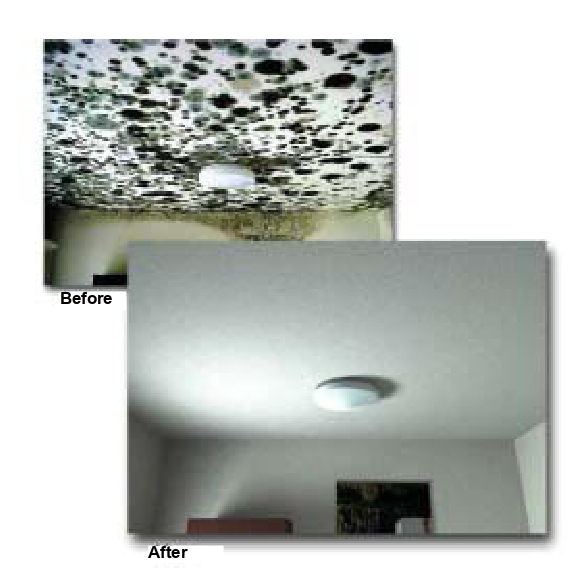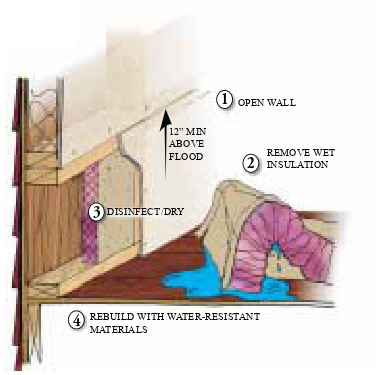- District Offices - 1621 Riverton Road Cinnaminson, NJ 08077
post

Mildew and molds are fungi – simple microscopic organisms that thrive anywhere there is a moist environment. Molds are a necessary part of the environment; without them, leaves would not decay and aspects of soil enrichment could not take place. It is their ability to destroy organic materials, however, that makes mold a problem for people – in our homes and in our bodies.
Mildew (mold in early stage) and molds grow on wood products, ceilingtiles, cardboard, wallpaper, carpets, drywall, fabric, plants, foods, insulation, decaying leaves and other organic materials.Mold growths, or colonies, can start to grow on a damp surface within24 to 48 hours. They reproduce by spores – tiny, lightweight “seeds”-that travel through the air. Molds digest organic material, eventually destroying the material they grow on, and then spread to destroy adjacent organic material. In addition to the damage molds can cause in your home, they can also cause mild to severe health problems. See the HEALTH section to check for possible moldrelated health problems.
If your home has water damage due to –
mildew and mold will develop within 24-48 hours of water exposure. Even worse, it will continue to grow until steps are taken to eliminate the source of moisture, and effectively deal with the mold problem. Use the diagram on the facing page to assess the extent of mold in your home. Then refer to the SOLUTION section for steps you need to take to remedy the problem. Also refer to the PREVENTION section for tips on keeping mold out of your home in the future.

Turn off main power if wiring is wet or moldy. Have electrician check the house’s electrical system before turning power on again.
Open the house to fresh air when the humidity is lower outside than inside.
Use fans and dehumidifiers to remove excess moisture unless mold has already started to grow (fans may spread existing mold).
Use the furnace only if the ducts have not been inundated (any forced air central heating ducts that have come in contact with water or mold should be professionally checked).
Remove all wet items such as furniture, rugs, bedding, toys, and carpeting.
Discard soaked or moldy carpeting! Clean and disinfect other items .
Discard all possibly contaminated food products – anything not in a water tight container.
Interior walls and Ceilings: Remove all wet or contaminated porous materials such as ceiling tiles, drywall, wood by-products. If wallboard is soaked, remove to a foot above the water mark and discard. Drain walls by removing baseboard and drilling holes near floor. Dry panel-type wall by pulling the bottom edge out from studs. Check interior of the wall for hidden mold.
Floors and Exterior walls: Remove all wet insulation. Discard all but rigid insulation, which can be reinstalled after disinfecting and drying.

Before you begin –
Make sure the working area is well ventilated.
Wear gloves, mask, and protect eyes.
If mold is present, clean a small test patch. If you feel your health is adversely affected, consider hiring a professional to carry out the work.
Disinfectants are intended to be applied to already cleaned materials.
Hard surfaces: Wash items such as metal, glass, solid wood, plastic, and other non-porous materials with a non-ammonia detergent and hot water.
Use a stiff brush on rough surface materials such as concrete.
Use a Wet-Dry shop vacuum to remove water and clean items such as studs or exposed wood framing.
Disinfect all cleaned surfaces with a 10% bleach solution. Let the solution stay on the surface for at least 10 minutes before rinsing with clear water or allowing to dry.
Porous materials: This includes upholstered furniture, rugs, bedding, clothing, curtains, books and papers, and furniture made of pressed particle materials. Deciding whether or not to keep contaminated item? Remember, when in doubt, throw it out. If an item has been wet for less than 48 hours, it may be able to be cleaned, disinfected with a phenolic or pine-oil cleaner. It should then be completely dried and monitored for several days for any fungal growth and odors– if any mold develops, discard the item.
Allow the wet or contaminated area to dry completely (usually two to three days) before beginning to rebuild, replace or return items. See MOLD PREVENTION section for tips on rebuilding, replacing.
We are all exposed to many kinds of mold both inside and outside the house. The exposure is greater in damp or wet conditions, especially when timely drying out does not have a chance to occur.
Of the thousands of molds that exist, some are known allergens (aggravating or causing skin, eye, and respiratory problems), and a few molds produce harmful mycotoxins that can cause serious problems. But all molds, in the right conditions and high enough concentrations, are capable of adversely affecting human health.
The potential for health problems occurs when people inhale large quantities of the airborne mold spores. For some people, however, a relatively small number of mold spores can cause health problems. Infants, children, immune-compromised patients, pregnant women, individuals with existing respiratory conditions, and the elderly are at higher risks for adverse health effects from mold.
Typical symptoms reported from mold exposure include:
The more serious health problems have been associated with the toxic black mold, Stachybotrys atra. The mold is greenish-black and slimy, resembling tar or black paint. Stachybotrys typically grows only on repeatedly wetted materials that contain cellulose – from paper to ceiling tiles, and any kind of wood. In most cases, this mold can be removed by a thorough cleaning with a 10% bleach solution. Severe mold infestations may require the assistance of a professional with experience in dealing with Stachybotrys.
If mold exposure is unavoidable, sensitive people should wear tightfitting masks or respirators.
There is no practical way for you to eliminate all of the molds and mold spores in the indoor environment. But there are many ways to help control moisture and mold growth in your home. Here is a partial list:
An excellent publication from the American Red Cross and FEMA is Repairing Your Flooded Home. This source of comprehensive information is available free from
FEMA Publications
PO BOX 70274
Washington, DC 20024
There are numerous internet sites that provide useful information about mold. Here is a sampling:
U.S. Environmental Protection Agency
http://www.epa.gov/iaq/molds/moldresources.html
U.S. Department of Health and Human Services / Centers for Disease Control and Prevention
http://www.bt.cdc.gov/disasters/mold/protect.asp
Alabama Department of Public Health
http://www.adph.org/IAQ/
Louisiana Department of Health and Hospitals – Louisiana Public Health Institute
http://www.stayhealthyla.org/mold.php
Mississippi Department of Health
http://www.msdh.state.ms.us/msdhsite
Texas Department of State Health Services
http://www.dshs.state.tx.us/